This article aims to provide an in-depth understanding of the various properties and benefits of thyme, a widely used and highly regarded herb in various cultures and traditional medicine systems. The article will explore the chemical composition, medicinal uses, culinary applications, and potential side effects of thyme, offering a well-rounded perspective on this versatile herb.
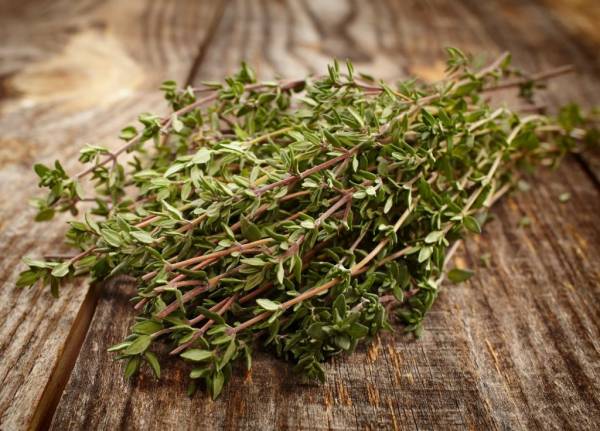
1. Introduction
1.1. Background and history of thyme
Thyme (Thymus vulgaris) is a perennial herb belonging to the Lamiaceae family, which also includes other aromatic herbs such as mint, basil, and oregano. It is native to the Mediterranean region and has been used for thousands of years for its culinary, medicinal, and ornamental properties. Thyme’s rich history dates back to ancient civilizations, including the Egyptians, Greeks, and Romans, who used it for various purposes.
In ancient Egypt, thyme was used in the embalming process due to its antimicrobial and preservative properties. The Greeks valued thyme for its aromatic qualities and believed it to be a symbol of courage and bravery. Greek soldiers often bathed in thyme-infused water to gain strength and vigor. Thyme was also used as an incense in Greek temples to purify the air and invoke positive energy.
The Romans adopted many of the Greeks’ uses for thyme, incorporating the herb into their bathing rituals, as well as using it as a flavoring agent in food and beverages. They also believed that thyme could protect against poisoning and was often served with meals to counteract any potential toxins. Roman soldiers were known to carry thyme as a source of courage and strength during battles.
Throughout the Middle Ages, thyme was used as a medicinal herb, a natural remedy for various ailments, and a culinary ingredient. It was also believed to have protective properties against evil spirits and was often planted in gardens or placed in homes as a means of warding off negativity.
1.2. Overview of thyme species and varieties
There are over 350 species of thyme, with Thymus vulgaris being the most common and widely cultivated. Thyme species can be classified into three main groups based on their growth habits: creeping thymes, shrub-like thymes, and upright thymes.
Creeping thymes, such as Thymus serpyllum, are low-growing ground cover plants that are well-suited for rock gardens or as edging plants. Shrub-like thymes, such as Thymus citriodorus, form small, bushy mounds and are often used as ornamental plants or for culinary purposes. Upright thymes, including the common Thymus vulgaris, grow in an erect, bushy manner and are primarily used for their culinary and medicinal properties.
Thyme varieties can also differ in their aroma and flavor profiles, with some having more pronounced lemon, orange, or mint notes. Additionally, certain varieties may be more suited for specific culinary or medicinal uses. Popular thyme varieties include common thyme (Thymus vulgaris), lemon thyme (Thymus citriodorus), caraway thyme (Thymus herba-barona), and woolly thyme (Thymus pseudolanuginosus).

2. Chemical Composition of Thyme
2.1. Essential oils and active compounds
Thyme contains a complex array of essential oils and active compounds that contribute to its diverse properties and benefits. The primary active constituents in thyme are its volatile oils, which are composed of various monoterpenes, sesquiterpenes, and phenolic compounds.
The most abundant and well-known compound in thyme essential oil is thymol, a phenolic monoterpene that possesses strong antimicrobial, antifungal, and antioxidant properties. Thymol is responsible for thyme’s distinctive aroma and many of its health benefits.
Other important constituents in thyme essential oil include carvacrol, another phenolic monoterpene with antimicrobial and antioxidant properties; linalool, a monoterpene alcohol with a calming effect; and borneol, a bicyclic monoterpene alcohol with anti-inflammatory and analgesic effects.
In addition to its volatile oil components, thyme also contains various non-volatile compounds, such as flavonoids, which contribute to its antioxidant and anti-inflammatory properties, and tannins, which have astringent effects.
2.2. Nutritional profile
Thyme is a nutrient-dense herb, providing a range of vitamins, minerals, and phytonutrients in relatively small amounts. Thyme is particularly high in vitamin C, an essential nutrient that supports immune function and acts as a potent antioxidant. It also contains significant amounts of vitamin A, which is important for eye health and immune function, and various B vitamins, including thiamin, riboflavin, niacin, and vitamin B6, which support energy metabolism and neurological function.
In terms of minerals, thyme is a good source of calcium, essential for bone health and muscle function; iron, which is necessary for red blood cell production and oxygen transport; magnesium, which supports muscle and nerve function and helps maintain a healthy heartbeat; and manganese, a trace mineral involved in many enzymatic reactions in the body.
The combination of thyme’s essential oils, flavonoids, tannins, vitamins, and minerals contribute to its numerous health-promoting properties and make it a valuable addition to a healthy diet.
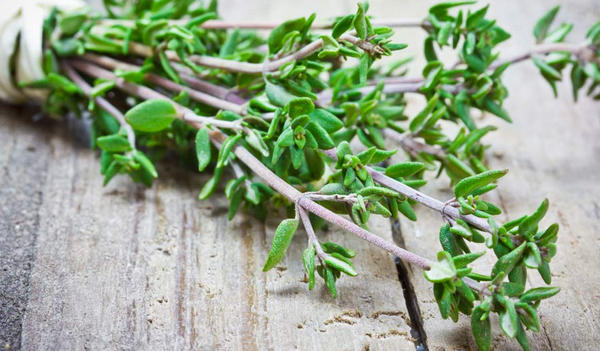
3. Medicinal Properties and Benefits of Thyme
3.1. Antimicrobial properties
Thyme is well-known for its antimicrobial properties, which are primarily attributed to the presence of thymol and carvacrol in its essential oil. These compounds have been shown to be effective against a wide range of bacteria, fungi, and viruses. Thyme’s antimicrobial activity makes it a valuable natural remedy for treating infections, as well as a potential preservative in food and cosmetic products.
3.2. Antioxidant properties
The essential oils and flavonoids in thyme exhibit strong antioxidant properties, helping to neutralize free radicals and protect the body from oxidative stress. Oxidative stress is associated with numerous health issues, including chronic inflammation, cardiovascular disease, and neurodegenerative disorders. Incorporating antioxidant-rich foods like thyme into your diet can help support overall health and prevent the development of various chronic diseases.
3.3. Anti-inflammatory properties
Thyme contains various compounds, such as thymol, carvacrol, and flavonoids, which have anti-inflammatory effects. These compounds can help reduce inflammation in the body, providing relief from inflammatory conditions like arthritis, asthma, and inflammatory bowel disease. Additionally, the anti-inflammatory properties of thyme may also contribute to its ability to protect against chronic diseases associated with inflammation, such as cardiovascular disease and diabetes.
3.4. Respiratory health benefits
Thyme has a long history of use as a remedy for respiratory issues, including coughs, bronchitis, and asthma. The herb’s antimicrobial, anti-inflammatory, and expectorant properties can help soothe the respiratory tract, reduce inflammation, and promote the clearance of mucus from the lungs. Thyme is often used in herbal teas, cough syrups, and chest rubs for its respiratory benefits.
3.5. Digestive health benefits
Traditionally, thyme has been used to support digestive health by relieving symptoms such as indigestion, gas, and bloating. Its carminative properties can help reduce gas formation and alleviate discomfort, while its antimicrobial effects may help protect against gastrointestinal infections. Additionally, thyme’s antispasmodic properties can help reduce muscle spasms and cramping in the digestive tract.
3.6. Mental and emotional health benefits
Thyme contains compounds like linalool, which have calming effects on the nervous system. As a result, thyme has been used as a natural remedy for anxiety, stress, and insomnia. Its uplifting aroma may also help improve mood and cognitive function, making it a popular ingredient in aromatherapy blends for relaxation and mental clarity.
3.7. Other potential health benefits
In addition to the benefits mentioned above, thyme has been studied for its potential effects on various other health conditions. Some research suggests that thyme may have anticancer properties, as certain compounds found in the herb have shown promise in inhibiting the growth of cancer cells. Thyme may also have potential in supporting skin health, oral health, and immune function, although more research is needed to fully understand these effects.
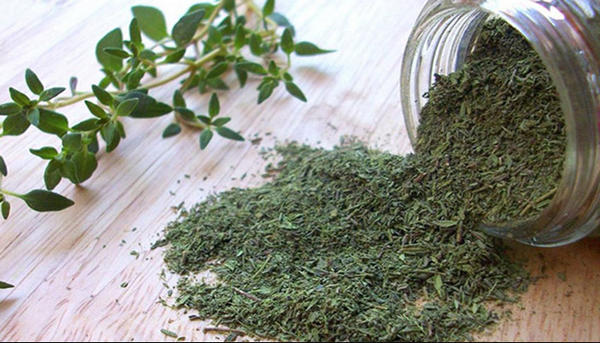
4. Culinary Uses of Thyme
4.1. Thyme in various cuisines
Thyme is a versatile herb with a warm, earthy flavor that complements a wide range of dishes. It is a staple ingredient in Mediterranean, French, and Middle Eastern cuisines, and is also commonly used in other culinary traditions around the world. Thyme pairs well with meats, poultry, fish, vegetables, legumes, and grains, adding depth and complexity to the flavor of dishes.
In Mediterranean cuisine, thyme is often used in spice blends like za’atar, which is popular in Lebanese, Palestinian, and Israeli cooking. In French cuisine, thyme is a key component of herbes de Provence, a mixture of dried herbs that is used to season various dishes, including roasted meats, vegetables, and soups. Thyme is also frequently used in Italian, Greek, and Spanish cooking, often in combination with other herbs such as oregano, rosemary, and basil.
4.2. Pairing thyme with other ingredients
Thyme’s earthy flavor makes it an excellent addition to a wide range of dishes, and it can be used both fresh and dried. When using fresh thyme, the leaves can be removed from the stem and added directly to the dish, or the whole sprigs can be added and removed before serving. Dried thyme is more concentrated in flavor and should be used sparingly.
Thyme pairs particularly well with the following ingredients:
– Meats: Beef, lamb, pork, and poultry
– Fish and seafood: Salmon, white fish, shrimp, and mussels
– Vegetables: Tomatoes, eggplant, zucchini, bell peppers, and mushrooms
– Legumes: Lentils, chickpeas, and beans
– Grains: Rice, pasta, and couscous
– Dairy: Cheese, yogurt, and cream
– Fruits: Lemons, oranges, and figs
– Herbs and spices: Rosemary, oregano, garlic, bay leaves, and marjoram
4.3. Tips for cooking and storing thyme
To get the most flavor from thyme, it is important to store and use it properly. Here are some tips for cooking with and storing thyme:
– Fresh thyme can be stored in the refrigerator for up to two weeks. To keep it fresh, wrap the stems in a damp paper towel and place them in a sealed plastic bag.
– Dried thyme should be stored in an airtight container in a cool, dark place, away from heat and sunlight. It will maintain its flavor for up to a year.
– When using fresh thyme, it is best to add it to the dish early in the cooking process to allow its flavors to develop and meld with the other ingredients.
– When using dried thyme, it is generally best to add it halfway through the cooking process to prevent the flavor from becoming too concentrated or overpowering.
– To release the essential oils and enhance the flavor of dried thyme, crush the leaves between your fingers before adding them to the dish.
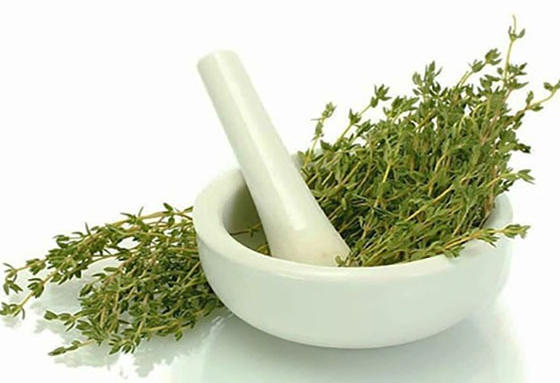
5. Thyme in Traditional Medicine Systems
5.1. Thyme in Ayurveda
Ayurveda, the ancient Indian system of medicine, has long recognized the therapeutic properties of thyme. In Ayurvedic texts, thyme is referred to as “Jangli Ajwain” or “Van Ajwain” and has been used to treat various health issues, including respiratory problems, digestive disorders, and skin infections. Thyme is believed to balance the Kapha and Vata doshas, while increasing the Pitta dosha. Due to its warming and drying properties, it is particularly beneficial for individuals with Kapha imbalances, such as excess mucus production or sluggish digestion.
5.2. Thyme in Traditional Chinese Medicine
In Traditional Chinese Medicine (TCM), thyme is known as “Bai Li Xiang” and is considered a warming and stimulating herb. It is used to treat conditions characterized by cold and dampness, such as respiratory infections, digestive issues, and rheumatism. Thyme is believed to help stimulate the flow of Qi (vital energy) and improve circulation, thereby promoting overall health and well-being. Its antibacterial, antiviral, and antifungal properties are also valued in TCM for treating various infections.
5.3. Thyme in European Herbal Medicine
Thyme has been a staple in European herbal medicine for centuries, with its use dating back to ancient Greece and Rome. In medieval Europe, thyme was widely cultivated for both its culinary and medicinal uses. It was commonly used to treat respiratory ailments, such as coughs, bronchitis, and asthma, as well as digestive issues like indigestion and bloating. Thyme was also believed to have protective properties, with people using it to ward off evil spirits and disease.
In modern European herbal medicine, thyme continues to be valued for its therapeutic properties, particularly its antimicrobial, antioxidant, and anti-inflammatory effects. It is used as a natural remedy for a wide range of health issues, including respiratory infections, digestive disorders, skin conditions, and anxiety. Thyme is often administered as a tea, tincture, essential oil, or in the form of dried or fresh herb preparations.
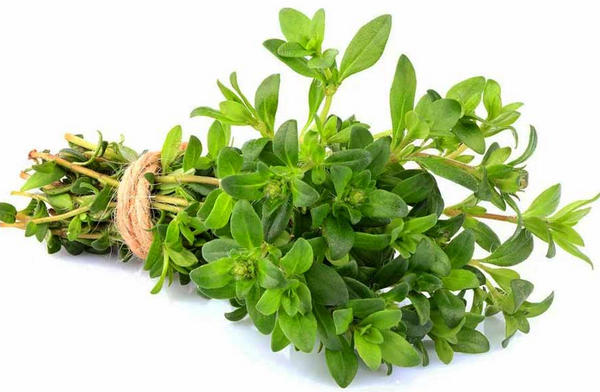
6. Thyme in Aromatherapy and Skincare
6.1. Thyme essential oil in aromatherapy
Thyme essential oil, which is extracted from the leaves and flowering tops of the plant, is widely used in aromatherapy for its various therapeutic properties. Its aroma is warm, herbaceous, and slightly spicy, and it is believed to promote mental clarity, concentration, and focus. Thyme essential oil can be used in a diffuser, or inhaled directly from the bottle, to help reduce stress, anxiety, and fatigue.
In addition to its mental and emotional benefits, thyme essential oil has antimicrobial, antifungal, and anti-inflammatory properties that can be beneficial for respiratory and immune system health. When used in a steam inhalation or diffuser, thyme essential oil can help relieve congestion, soothe respiratory irritation, and support the body’s natural defenses against colds and flu.
6.2. Thyme in skincare products
Thyme’s antimicrobial, anti-inflammatory, and antioxidant properties make it a valuable ingredient in skincare products. Thyme essential oil and thyme-infused extracts can be found in a variety of products, such as cleansers, toners, creams, and serums, designed to address various skin concerns.
Thyme can be beneficial for acne-prone skin due to its antimicrobial properties, which can help reduce the presence of acne-causing bacteria on the skin. Its anti-inflammatory effects can also help soothe redness and irritation associated with acne and other inflammatory skin conditions.
As an antioxidant, thyme can help protect the skin from environmental stressors and promote a more youthful, radiant appearance. It may also help improve skin tone and texture, making it a popular ingredient in products designed to address uneven pigmentation or signs of aging.
6.3. Precautions and safety considerations
While thyme and thyme essential oil have numerous benefits, it is important to use them safely and appropriately. Thyme essential oil should always be diluted with a carrier oil, such as almond or jojoba oil, before applying it to the skin to avoid irritation.
In aromatherapy, thyme essential oil should be used sparingly and in moderation, as excessive use can lead to headaches or dizziness. It is not recommended for use during pregnancy or by individuals with high blood pressure, epilepsy, or hyperthyroidism, as it may have stimulating effects on the body.
As with any herbal remedy or skincare product, it is essential to consult with a healthcare professional or qualified aromatherapist before using thyme for therapeutic purposes, especially if you have any underlying health conditions or are taking medications.
7. Growing Thyme and Cultivating Varieties
7.1. Selecting thyme varieties
Thyme is available in numerous varieties, each with its unique characteristics, flavors, and uses. Some common varieties of thyme include:
– Common thyme (Thymus vulgaris): This is the most widely cultivated variety, known for its strong, earthy flavor and numerous medicinal properties. It is often used in cooking, as well as in herbal remedies and essential oil production.
– Lemon thyme (Thymus citriodorus): This variety has a distinct lemon scent and flavor, making it a popular addition to fish, poultry, and vegetable dishes. It also has similar medicinal properties to common thyme.
– Creeping thyme (Thymus serpyllum): This low-growing variety is often used as a ground cover or in rock gardens. It has a milder flavor than common thyme and can be used in cooking, although it is less frequently used for medicinal purposes.
– Woolly thyme (Thymus pseudolanuginosus): This variety is known for its soft, fuzzy leaves and is primarily grown as an ornamental plant, rather than for culinary or medicinal use.
7.2. Growing conditions and care
Thyme is a hardy perennial herb that is relatively easy to grow in most climates. It prefers full sun and well-draining soil with a neutral to slightly alkaline pH. Thyme can tolerate some drought and does not require frequent watering; in fact, overwatering can lead to root rot and other issues.
To grow thyme from seed, sow seeds indoors about 6-8 weeks before the last expected frost in your area. Transplant seedlings outdoors after the risk of frost has passed, spacing them about 12 inches apart. Thyme can also be propagated from cuttings or by dividing established plants.
Pruning thyme plants regularly can help maintain their shape and promote bushier growth. Harvest thyme leaves as needed throughout the growing season, but avoid taking more than a third of the plant at a time to prevent stressing the plant.
7.3. Harvesting and preserving thyme
To harvest thyme, simply snip off the desired amount of sprigs or individual leaves with a pair of scissors or garden shears. Thyme can be harvested throughout the growing season, although the flavor is typically at its peak just before the plant flowers.
Thyme can be used fresh or dried for later use. To dry thyme, tie small bundles of sprigs together and hang them upside down in a warm, dry, well-ventilated area, away from direct sunlight. Once the leaves are completely dry and crumbly, strip them from the stems and store them in an airtight container in a cool, dark place.
Fresh thyme can also be frozen for later use. Simply wash and dry the sprigs, then place them in a single layer on a baking sheet lined with parchment paper. Freeze the sprigs until they are firm, then transfer them to a freezer-safe container or plastic bag for long-term storage.


